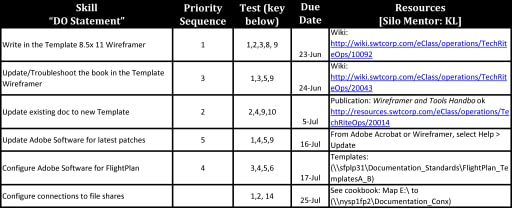 Steve Trautman has once again asked me to act as guest blogger to share a recent client story that pointedly illustrates a substantial advantage of our 3-step knowledge transfer process over typical forms of knowledge transfer:
I received a fabulous anecdote recently on a knowledge transfer scorecard from one of my favorite clients. (The knowledge transfer scorecard is a status reporting tool that enables managers to hold their teams accountable to knowledge transfer goals and keeps senior executives informed of a team’s progress. The scorecard, typically filled out bi-monthly, includes a notes section for important anecdotes, problem-solving, and team wins.) The notes section of this client’s scorecard stated:
“The importance of doing task testing became apparent this week when the [ X ] knowledge silo apprentice indicated he did not feel comfortable with the ‘in process task’ [in other words, the skill currently being taught] and requested additional review time and retesting.”
My knee-jerk reaction as the lead consultant on the project was: this is awesome! The Skill Development Plan (step two of our 3-Step Knowledge Transfer Solution) is working as intended. My reaction might sound counterintuitive since the note meant that a learning cycle had to be slowed, so let me explain.
I’ve been a Master Consultant for The Steve Trautman Co.’s knowledge transfer program for fifteen years. I’ve seen the benefits of the Skill Development Plan (SDP) from both the mentor and the apprentice perspective. And, I’ve heard a bit of push-back from numerous clients regarding our knowledge transfer test questions—the assessment feature included in the SPD that tests that knowledge did transfer and was absorbed by the apprentice. The most common push-back I initially hear is that mentors and apprentices are “uncomfortable” using the test questions. Ok, I get that. No one feels like they want to quiz their peers/colleagues. It’s much more “comfortable” to let knowledge transfer happen the usual route.
What typically happens in the workplace is trial-and-error knowledge transfer and what I call the polite “smile and nod”: if there is no structured knowledge transfer process and no test questions, an employee tagged by management as a learner (apprentice) feels compelled to answer a Subject Matter Expert’s (mentor’s) question, “Do you now understand how to do this new skill?” with, “I got it,”—even when the apprentice has little clue. Too often, after a mentor’s unstructured explanation of a skill or task an apprentice feels like he should nod and say, “I’m ready.” The busy mentor is usually so thrilled to hear those words that she takes the remark at face-value. Both move forward without the confirmation of testing. That’s when costly mistakes in daily work begin to occur.
Now, let’s look at what happens with our 3-step approach. The third column in the SDP lists the 3 – 5 test questions (selected from a default list of 20) that a mentor has chosen in advance to be the apprentice’s assessment for the skill being taught. Including the questions in the SDP ensures the mentor doesn’t forget to teach this critical information during the on-the-job training session with the apprentice [Figure 1]. It’s a reminder to include in the session that wisdom and tacit knowledge the mentor has gained through years of experience, as well as a reminder to the apprentice to be accountable for learning this knowledge, which is likely not documented elsewhere.
The apprentice knows in advance what he will be tested on; at the assessment time he must verbally answer these questions to the satisfaction of the mentor. Bottom line: I want both the mentor and the apprentice to have reliable confidence that the apprentice is ready to perform the task independently on the job. (I also love that we provide a second reminder to mentors about these questions in the 5-Minute Meeting Plan Agenda tool used to help prepare a mentor to organize her thoughts before teaching each 1-hour knowledge transfer session.)
My client’s scorecard note above proved how valuable these test questions were for the apprentice. It gave him a clear way to recognize his un-readiness and ask for what he needed. We know our mentors have very busy and demanding jobs—they’re our Subject Matter Experts (SMEs) after all. Sometimes we forget our apprentices are very busy, too. (Apprentices are not all new hires—they may be longtime employees who are new to a department, whose job role has been changed, or who are absorbing new technologies or processes.) The apprentice may be a SME in different knowledge areas (“knowledge silos”) and they’re cross-training into a new silo to help mitigate a bench strength risk (which was the case with client’s apprentice).
The date column on the SDP is designed to be the date by which the apprentice feels comfortable that he can answer the test questions for that line item’s skill to the satisfaction of the mentor. This means the date is after the 1 hour knowledge transfer session with the mentor and after the apprentice is given time to independently review resources (supporting documentation, wikis, templates, examples, etc.), until the apprentice has confidence he is ready to perform the task independently on the job. The resource review and practice could take an additional hour—or it could take weeks or months, depending upon the complexity of the skill and the robustness of the resources.
As my client’s scorecard illustrates, writing the test questions for a task and the testing date into the apprentice’s Skill Development Plan afforded him the ability to say, “I’m not ready yet. Let’s change the testing date. I need more time to review resources and practice.” This shows the apprentice accepted responsibility for his own learning and, in the end, yielded a much better assurance of competence when the apprentice—after begin given additional practice time—took and passed his test with flying colors. Hooray for test questions!
SUMMARY: A central difference between our 3-step knowledge transfer process and more ad-hoc methods is that our process includes a simple metrics—verbal test questions—to measure whether critical knowledge has been transferred and retained by employees. Using the test questions safeguards the transfer of a mentor’s tactic knowledge in addition to explicit, and it ensures accountability by eliminating the option for apprentices to pretend they have learned (give a polite “nod and smile”)—which could have dire consequences when these employees are called upon to work independently. As peer mentors and apprentices use our process, they both come to appreciate the test questions as a way to ensure teammates are ready, to enable apprentices to take ownership of the pace of their learning, and to feed peer- and self-confidence.
Steve Trautman has once again asked me to act as guest blogger to share a recent client story that pointedly illustrates a substantial advantage of our 3-step knowledge transfer process over typical forms of knowledge transfer:
I received a fabulous anecdote recently on a knowledge transfer scorecard from one of my favorite clients. (The knowledge transfer scorecard is a status reporting tool that enables managers to hold their teams accountable to knowledge transfer goals and keeps senior executives informed of a team’s progress. The scorecard, typically filled out bi-monthly, includes a notes section for important anecdotes, problem-solving, and team wins.) The notes section of this client’s scorecard stated:
“The importance of doing task testing became apparent this week when the [ X ] knowledge silo apprentice indicated he did not feel comfortable with the ‘in process task’ [in other words, the skill currently being taught] and requested additional review time and retesting.”
My knee-jerk reaction as the lead consultant on the project was: this is awesome! The Skill Development Plan (step two of our 3-Step Knowledge Transfer Solution) is working as intended. My reaction might sound counterintuitive since the note meant that a learning cycle had to be slowed, so let me explain.
I’ve been a Master Consultant for The Steve Trautman Co.’s knowledge transfer program for fifteen years. I’ve seen the benefits of the Skill Development Plan (SDP) from both the mentor and the apprentice perspective. And, I’ve heard a bit of push-back from numerous clients regarding our knowledge transfer test questions—the assessment feature included in the SPD that tests that knowledge did transfer and was absorbed by the apprentice. The most common push-back I initially hear is that mentors and apprentices are “uncomfortable” using the test questions. Ok, I get that. No one feels like they want to quiz their peers/colleagues. It’s much more “comfortable” to let knowledge transfer happen the usual route.
What typically happens in the workplace is trial-and-error knowledge transfer and what I call the polite “smile and nod”: if there is no structured knowledge transfer process and no test questions, an employee tagged by management as a learner (apprentice) feels compelled to answer a Subject Matter Expert’s (mentor’s) question, “Do you now understand how to do this new skill?” with, “I got it,”—even when the apprentice has little clue. Too often, after a mentor’s unstructured explanation of a skill or task an apprentice feels like he should nod and say, “I’m ready.” The busy mentor is usually so thrilled to hear those words that she takes the remark at face-value. Both move forward without the confirmation of testing. That’s when costly mistakes in daily work begin to occur.
Now, let’s look at what happens with our 3-step approach. The third column in the SDP lists the 3 – 5 test questions (selected from a default list of 20) that a mentor has chosen in advance to be the apprentice’s assessment for the skill being taught. Including the questions in the SDP ensures the mentor doesn’t forget to teach this critical information during the on-the-job training session with the apprentice [Figure 1]. It’s a reminder to include in the session that wisdom and tacit knowledge the mentor has gained through years of experience, as well as a reminder to the apprentice to be accountable for learning this knowledge, which is likely not documented elsewhere.
The apprentice knows in advance what he will be tested on; at the assessment time he must verbally answer these questions to the satisfaction of the mentor. Bottom line: I want both the mentor and the apprentice to have reliable confidence that the apprentice is ready to perform the task independently on the job. (I also love that we provide a second reminder to mentors about these questions in the 5-Minute Meeting Plan Agenda tool used to help prepare a mentor to organize her thoughts before teaching each 1-hour knowledge transfer session.)
My client’s scorecard note above proved how valuable these test questions were for the apprentice. It gave him a clear way to recognize his un-readiness and ask for what he needed. We know our mentors have very busy and demanding jobs—they’re our Subject Matter Experts (SMEs) after all. Sometimes we forget our apprentices are very busy, too. (Apprentices are not all new hires—they may be longtime employees who are new to a department, whose job role has been changed, or who are absorbing new technologies or processes.) The apprentice may be a SME in different knowledge areas (“knowledge silos”) and they’re cross-training into a new silo to help mitigate a bench strength risk (which was the case with client’s apprentice).
The date column on the SDP is designed to be the date by which the apprentice feels comfortable that he can answer the test questions for that line item’s skill to the satisfaction of the mentor. This means the date is after the 1 hour knowledge transfer session with the mentor and after the apprentice is given time to independently review resources (supporting documentation, wikis, templates, examples, etc.), until the apprentice has confidence he is ready to perform the task independently on the job. The resource review and practice could take an additional hour—or it could take weeks or months, depending upon the complexity of the skill and the robustness of the resources.
As my client’s scorecard illustrates, writing the test questions for a task and the testing date into the apprentice’s Skill Development Plan afforded him the ability to say, “I’m not ready yet. Let’s change the testing date. I need more time to review resources and practice.” This shows the apprentice accepted responsibility for his own learning and, in the end, yielded a much better assurance of competence when the apprentice—after begin given additional practice time—took and passed his test with flying colors. Hooray for test questions!
SUMMARY: A central difference between our 3-step knowledge transfer process and more ad-hoc methods is that our process includes a simple metrics—verbal test questions—to measure whether critical knowledge has been transferred and retained by employees. Using the test questions safeguards the transfer of a mentor’s tactic knowledge in addition to explicit, and it ensures accountability by eliminating the option for apprentices to pretend they have learned (give a polite “nod and smile”)—which could have dire consequences when these employees are called upon to work independently. As peer mentors and apprentices use our process, they both come to appreciate the test questions as a way to ensure teammates are ready, to enable apprentices to take ownership of the pace of their learning, and to feed peer- and self-confidence. Let’s Get In Touch!
Submit your information and we'll get in touch about services:

